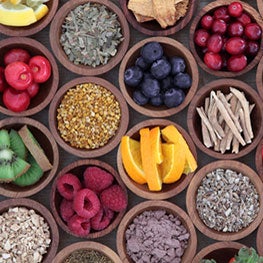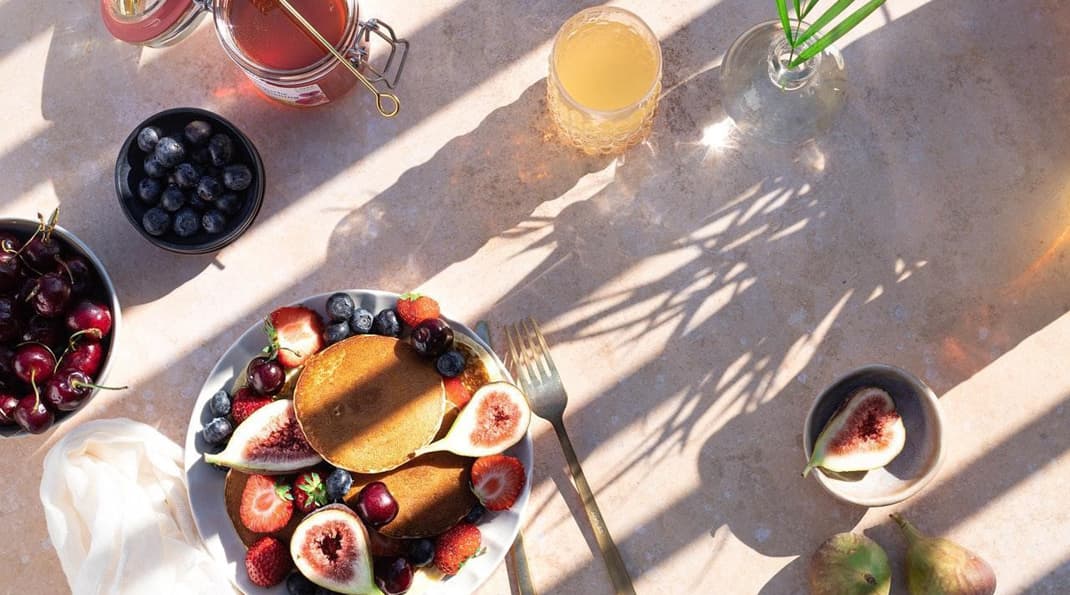A Guide To Gluten: A Gluten Free Diet Plan For Beginners

Gluten can be found in all sorts of foods, which can be difficult if you’re someone who doesn’t react very well to eating it.
Luckily, following a gluten-free diet is more common these days — as are gluten-free alternatives — so it doesn’t have to be stressful cutting out gluten from your diet.
If you’re thinking about going gluten-free or you simply want to learn more about gluten and the effect it can have, you’ve come to the right place. In this guide, you can learn to recognise foods that contain gluten and how some people can benefit from a gluten free diet. You can also find tips and advice for creating a gluten-free diet plan for beginners.
What is gluten?
Gluten is the general name for the type of proteins that are found in certain cereal grains, such as wheat, barley and rye.
Gluten helps food to maintain its shape — acting as a ‘glue’ (where the name originally comes from) to hold the food together. This happens when flour (made up of grains containing gluten) is mixed with water to form a sticky, elastic network, which stretches and traps gas. It is what allows bread and similar products to rise during baking, keeps moisture in pasta and bread, and provides the characteristic soft, chewy texture of these foods.
As well as being found naturally in grains, it is often used as an additive in processed foods to improve texture, add flavour, retain moisture, and as a thickening agent.
Gluten intolerance vs. coeliac disease
Although gluten has unique and beneficial properties when it comes to making food, it can be harmful to some people, particularly in large quantities.
Some people are unable to tolerate gluten, which is known as gluten sensitivity or gluten intolerance. This causes symptoms such as bloating, abdominal pain, nausea, diarrhoea and constipation. These reactions are short-term and don’t normally cause any long-term harm to the body.
On the other hand, coeliac disease is a more serious health condition that can cause all sorts of harmful reactions in the body.
Coeliac disease is an autoimmune condition in which the immune system is triggered by the presence of gluten in your body, and mistakenly attacks the lining of your gut (small intestine). This stops the body from absorbing nutrients from food and causes a range of symptoms including digestive reactions — and may contribute to other, more serious longer-term medical complications.
Coeliac disease can be treated by completely removing gluten from the diet but it can’t be cured.
Foods with gluten
Gluten can be found in a variety of whole and processed foods.
The most common foods with gluten are:
- Cereals or grains: the three most common grains that gluten is found in are wheat (including both whole wheat and wheat bran), barley and rye. Gluten can also be found in other varieties and derivatives of wheat and other grains, such as oats, spelt, bulgur, farro, freekeh, semolina, durum, wheat germ and cracked wheat.
- Cereals or grain-based products: all wheat containing breads, breadcrumbs, pasta, noodles, couscous, gnocchi, breakfast cereals, pastries, cakes, muffins, cookies, waffles, pancakes, crackers and flour tortillas.
- Some processed foods and products (though not necessarily in all of the following): some ready meals, meat substitutes such as veggie burgers soups and broths, malt vinegar, soy sauce, sauces and gravies, salad dressings, spice blends, flavoured chips, energy bars, beers and yeast spreads.
Some foods with gluten may be obvious, while others can contain hidden gluten. This is because gluten is often used in food production to thicken or stabilise.
For those following a strict gluten free diet, such as those with Coeliac Disease, reading and understanding a food label is very important. All allergens such as wheat/gluten must be present on food labels to help identify if the food is appropriate to eat.
Gluten-free food
Although gluten can be found in lots of different foods, there are plenty of gluten-free food options out there.
If you are thinking about starting a gluten-free diet plan, here are some foods that are gluten-free:
- Quinoa, corn, brown rice, wild rice, buckwheat and tapioca
- Gluten free breads, pasta and cereals
- Fresh fruit and vegetables (you will need to check canned, frozen or dried fruit and vegetables)
- Pulses and legumes such as beans, lentils and peas
- Fresh red meat and poultry (check any processed meats, lunch meats and ready meals)
- Fresh fish and seafood (check any breaded or battered fish)
- Dairy products such as milk, cheese, butter, cream and yogurt (check anything flavoured or processed)
- Nuts and seeds
It can feel overwhelming if you’re changing to a gluten-free diet plan, but there are lots of gluten-free foods to include in your diet, especially if you stick to fresh produce. Plus, it is now possible to buy gluten-free versions of food products that would typically contain gluten, such as bread, cereal and pasta.
Any processed versions of the food we’ve listed above will need to be double-checked to ensure that they don’t contain gluten. Always read the label or check with the manufacturer if you can’t easily find this information.
Alternatively, there are also a range of gluten-free nutritional supplements available that provide your body with a range of nutrients that you might be missing out on such as calcium, fibre and protein if you are not following a nutritionally balanced gluten-free diet.
What is a gluten-free diet?
A gluten-free diet is one in which you do not consume any food products that contain gluten.
This is usually because of the adverse reaction your body has to gluten, whether it is gluten intolerance or the more serious coeliac disease.
To stay healthy and avoid any negative side effects, a person with Coeliac disease or gluten intolerance should avoid all foods that contain gluten — even the smallest amount can cause a variety of symptoms. For people with coeliac disease, even small hidden amounts of gluten can cause serious damage to the small intestine without any symptoms. Therefore, the avoidance of contamination is particularly important for these individuals.
Following a gluten-free diet plan
Creating a gluten-free diet plan can seem tricky at first. Here are some helpful tips to follow when making a gluten-free diet plan for beginners:
- Plan ahead: mapping out your week with a seven-day gluten-free diet plan will help you stick to gluten-free food and meals.
- Always read the label: foods containing gluten will be labelled with an allergen statement.
- Buy a gluten-free cookbook: this will help you to source new ideas and recipes, and allow you to be more creative with gluten-free ingredients in the kitchen.
- Call ahead when eating out: if you’re heading to a cafe or restaurant, let them know that you’re gluten-free so that you’ll have more options when you dine out. You can also look for ‘GF’ on the menu when you’re at the restaurant or researching online.
- Bring your own gluten-free versions: whether you’re visiting friends or family, or going away for the weekend, bringing your own gluten-free bread or pasta may sometimes be easier. People don’t mean to, but they can sometimes forget.
- Seek out professional support from a trained healthcare professional to ensure you are maintaining a healthy balanced diet that supports your specific health needs
Following these tips will help you when it comes to staying gluten-free. Making a gluten-free diet plan for beginners can also help.
Making a gluten-free diet plan for beginners
If you’re new to it, going gluten-free can be daunting — but mapping out your meals a week at a time can help you to avoid gluten in your diet.
Here is a rough example of what a day of meals could look like in a gluten-free diet plan for beginners:
Day 1
- Breakfast: Greek yoghurt with fresh fruit and chia seeds. Fruit and chia seeds are also rich in fibre. Take a look at our dietary fibre guide to find out more
- Snack: an apple, handful of pistachios and a SUSTAGEN Ready to Drink carton
- Lunch: grilled chicken breast and salad in a gluten-free wrap
- Snack: carrot sticks
- Dinner: lamb and roast vegetables with a side of quinoa
Sticking to fresh produce, eating a varied diet, using gluten-free substitutes and always reading the label will help ensure you are following a gluten-free diet.
Gluten-free nutritional supplements
A gluten free diet is required for those who have diagnosed Coeliac Disease and may help support those with suspected Gluten intolerance.
However, you may find that you aren’t getting enough of a few key vitamins and minerals to meet your daily recommendations if you are gluten-free. To ensure you are not missing any essential nutrients in your gluten-free diet, you may consider additional supplementation to help support your needs.
In particular, people eating a gluten-free diet may need to boost their levels of essential nutrients such as zinc, vitamin B12, calcium, iron, folate and magnesium.
If this is the case, there are gluten-free supplements that can help replenish nutrients you may lose by following a gluten-free diet plan.
These could be:
- Vitamin tablets
- Gluten-free shakes or smoothies
- Protein powder (For more information, take a look at our ‘What Is Protein’ guide)
- Nutritional supplement drinks
Always check the label with any vitamins or supplements; certain inactive ingredients may contain gluten.
At SUSTAGEN, we offer a range of gluten-free nutritional supplements and drinks, including SUSTAGEN Hospital Formula, SUSTAGEN Hospital Formula Plus Fibre, and SUSTAGEN Ready to Drink.
Adding SUSTAGEN gluten-free supplements into a gluten-free diet is really easy. Simply add scoops into drinks or recipes, or take a SUSTAGEN Ready to Drink carton with you if you’re on the go.
SUSTAGEN Hospital Formula is a formulated meal replacement and cannot be used as a total diet replacement. Consume as part of a varied and balanced diet and healthy lifestyle.
SUSTAGEN Hospital Formula + Fibre is a formulated meal replacement and cannot be used as a total diet replacement. Consume as part of a varied and balanced diet and healthy lifestyle.
SUSTAGEN Ready to Drink is a Formulated Supplementary Foods which can be of assistance where dietary intakes of nutrients and energy may not be adequate. Consume as part of a varied and balanced diet and healthy lifestyle.
Sources
- https://www.nhs.uk/conditions/coeliac-disease/
- https://celiac.org/about-celiac-disease/what-is-celiac-disease/
- https://celiac.org/gluten-free-living/what-is-gluten/sources-of-gluten/
- https://www.verywellhealth.com/nutrients-to-boost-if-youre-gluten-free-563076
- Gluten free diet and nutrient deficiencies: A review - PubMed (nih.gov)
- Wheat and a low FODMAP diet - A blog by Monash FODMAP | The experts in diet for IBS - Monash Fodmap
- Coeliac Australia Home




